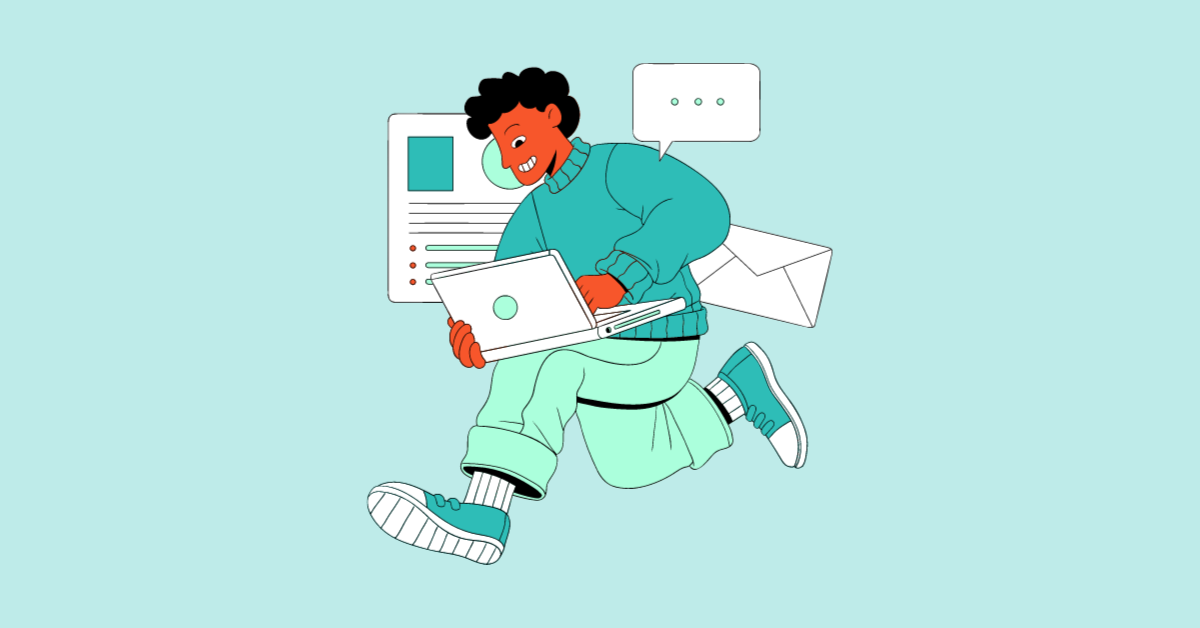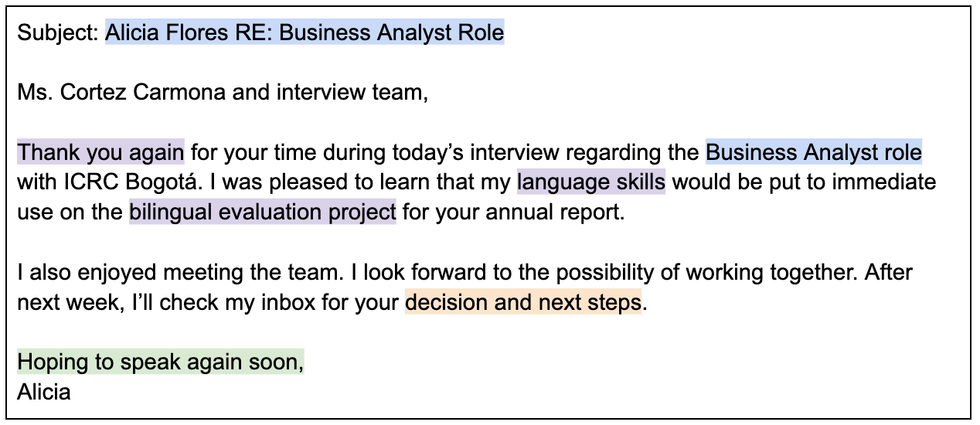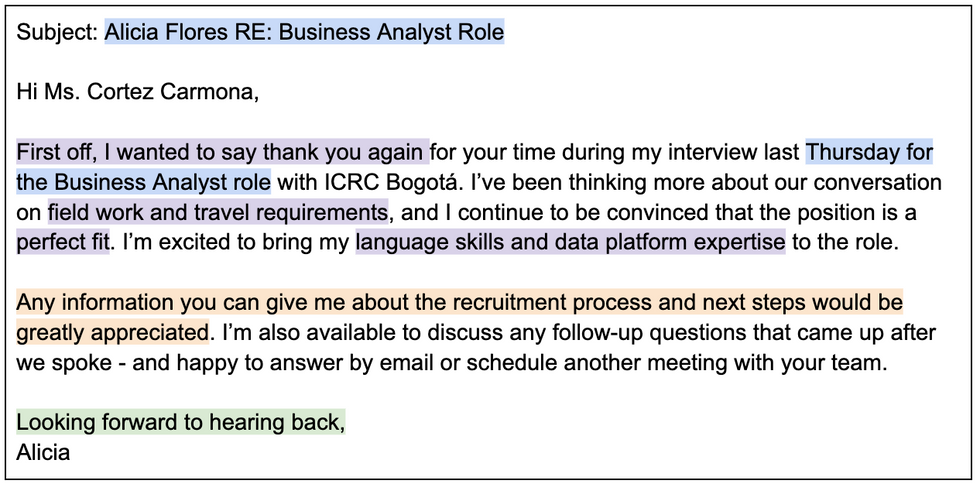Writing your follow-up email after an interview can be a hard egg to crack. You nailed the post-interview thank you email. Now, you want to be direct, yet tactful in your pursuit of updates. Express enthusiasm, without sounding desperate. It’s a tricky email to craft.
Choosing the right words to communicate to your future potential boss that you do, in fact, want the job is sometimes an uncomfortable task, but always worth doing. Before you hit send, take a moment to review best practices and avoid mistakes that could sabotage your chances. Most important to remember? In your follow-up email after an interview, you need to stand out. Here are four ways to actually make an impression with what you send.
1. Be timely
It’s 2023 and you just exited your Zoom job interview. Things went well. You are excited about the role, and your mind is searching for ways to solidify your chances at getting an offer. What do you do next?
Send your thank you email immediately. Specifically, get it done the same day or early the following business day. This helps the team connect your professional etiquette to the person they met.
When it comes to further follow-up emails, pump the breaks. Your chances improve greatly if the next communication you send, after initially thanking your interviewers for their time, is strategic. Is it human nature to want an update on the hiring timeline? Yes. Does it feel especially urgent when the interview went well? Also yes. But the payoff is in playing your cards right. .
How long should you wait after an interview to follow up?
Remember that recruiters and hiring teams are literally still interviewing for the position. Think back to the hiring timeline they described towards the end of your conversation. If they mentioned a specific end date for interviews, stick to their schedule. Send something too soon, and your hiring team may perceive you as pushy or high-maintenance. Send your follow-up email after the date has passed for the next round in the interview process.
2. Be original
You don’t want your follow-up email after an interview to get lost amongst the rest. The simplest way to stick out to a recruiter or hiring team is to be original in your communications.
Don’t copy and paste your email text. Not only do interviewers not want to think they’re just one in a group of indistinguishable employers, but some email web services change the color on email text if it’s copy-and-pasted. This formatting might give you away, even if you don’t notice anything on your end.
3. Be professional
Writing a professional-sounding email should be obvious advice, right? Not necessarily. From the tech influence of Silicon Valley’s casual offices to the work-from-home, half-dressed office wear of the pandemic, there’s plenty about office professionalism that has relaxed in recent years.
Email etiquette, generally speaking, is no different. But though times have changed, emails are still expected to be somewhat formal in tone.
Ditch “hasta la pasta”
Plenty of unprofessional emails have gone viral on social media. Some of these instances even made headlines, when a CEO reported shocking sign-offs from his employees such as “hasta la pasta” and “talk soon, loser.”
Maintain a formal tone
You want your follow-up email after the interview to stand out, but not for the wrong reasons. Keep your follow-up courteous in both tone and vocabulary. While your personality can shine in interviews, emails are not the time for jokes or unprofessional language. If the purpose of your message is to ask for an update on the hiring timeline, get to the point and ask directly. At this stage, nothing flashy or clever will beat out a clear, concise, and professional message.
4. Be engaging
You are a mid-career professional. You’re likely focused on making a name for yourself in your industry. Interviews aren’t merely about hoping to get hired anymore, but a serious two-way conversation to find out if the company is right for you.
Most small businesses make hiring decisions in two rounds of interviews or fewer. You can expect additional rounds at larger companies. Use this time wisely. Voice these things that stood out to you about the role.
- Do the company’s values match yours?
- Does the role fit your career growth strategy?
- Did the interview leave a lasting impression or lingering doubts in your mind?
Remember to keep notes during the interview itself. This way, you can refer to them for the follow-up email after the interview. The more specifics that stand out from the conversation, the more your interview team will remember you individually.
5. Be concise
On average, a corporate job opening in the U.S. today receives approximately 250 applications. Of those applications, the company typically invites six to 10 candidates for an interview before finally narrowing that number down to the top two or three candidates.
You’re still competing against well-qualified peers. Your interview team is facing an inbox full of emails from applicants at every stage of the process. Make their job easier by keeping things short. They’ll thank you for it, trust us.
Follow-up email examples and templates
Where should you send your follow-up email after the interview? Your best bet is to respond directly to the most recent email exchange between you and the interviewer. Keep that back-and-forth momentum. If you were contacted by a recruiter, email the HR manager or hiring team directly.
Don’t forget to reiterate the job title and interview day alongside your name. Providing the interview details upfront saves them search time and demonstrates your organizational skills in everyday exchanges. It also makes it easier for them to get back to you quickly.
Finally, don’t be too proud to use a spell-checker. There are free online services like Language Tool that allow you to drop in a short text block of your email. It will instantly identify grammar errors, spacing issues, and spelling mistakes. You want your follow-up email after the interview to be neutral or improve your image, not bring it down. So, what should the email say exactly? Here is a template with examples.
Follow-up email template
There are four basic elements that should be included in any follow-up email after an interview.
Post-interview thank you email
Your objective here is to thank the interview team for their time and double down on your interest in the job. This time-tested practice will reinforce the good impression you made during the interview itself. This email should go out immediately, either the same day or early the following business day.
Follow-up email asking for interview results
You sent the initial thank you email after your interview. Now, how do you politely ask for an interview result? Here is one example.
Follow-up message on social media or chat apps
In the modern age, there may be cases where you need to message the recruiter or interview team via social media or chat apps. Whether a direct message on LinkedIn or a short message to a WhatsApp group chat or Slack user group, this message is slightly different from an email. Though it can be less formal (while still professional) and limited in length, it should still contain the same basic elements.
Note: In this case, compared to email, not everyone will have a way to contact you privately. Add contact information or drop your QR code at the end of the message so group members can save you individually or reply separately from the group.
Follow-up email if you are rejecting the role
Not every interview goes as expected. As we always stress to applicants, though the job environment is more competitive than ever, your career goals are important for a win-win placement.
If a job interview doesn’t feel like a good fit, it’s ok to turn it down. This is still a networking opportunity. Use this communication to establish a professional working relationship with the recruiter or hiring team and keep the lines of communication open.
Follow-up email to stay in touch after rejection
Chalk it up to an internal decision and move along to the next application. Have you wasted your time? Not necessarily. To make lemonade out of these lemons, consider your interview a networking opportunity. Use your follow-up email after the interview and no response (or outright rejection) as a classy way to connect with the recruiter and the company. A graceful response can have quite the impact.
Hiring processes in the modern age
Clearly, times are changing. Follow-up emails after interviews have always been tricky, but professionalism never goes unappreciated. At this point in your career, interviews are information-rich conversations. You get to decide if the fit is right. When it comes to the follow-up, avoid cookie-cutter emails without personal branding. This is the time to be original and engaging while asking the questions that will inform your decision. Excited and ready to jump into an application process with a company that shares your professional values? Check out the PowerToFly job board and look for your dream job today.









